Hearken to the interview with Marcus Luther:
Sponsored by Fearless Faculties and Learn&Write by Texthelp
“Classroom tradition” is a kind of phrases that’s stated 1000’s of occasions over, typically with out the “how” and “why.”
Going into the 2021-2022 faculty 12 months, certainly one of personal self-commitments—particularly after a lot time final 12 months with out college students in a bodily classroom—was to not solely honor the worth of group in our classroom with my phrases, however to really make investments time and house inside our studying expertise to affirm this worth. (That is additionally why the fifth and closing core perception of our classroom is constructed round group: We’re every an essential a part of our group, and our presence and voice issues.)
With out affording time and house, our values come throughout as somewhat empty, in any case.
So three months into the varsity 12 months, it was time to “pay the piper” in our AP Literature classroom in a significant method. This meant veering away from regular processes of literary evaluation and having college students not solely write their very own reflective narrative poems, however spend time in an unbelievable, silent house shifting across the library and writing notes of affirmation on one another’s writing.
Right here is “how” we made it occur, then, in addition to “why.”
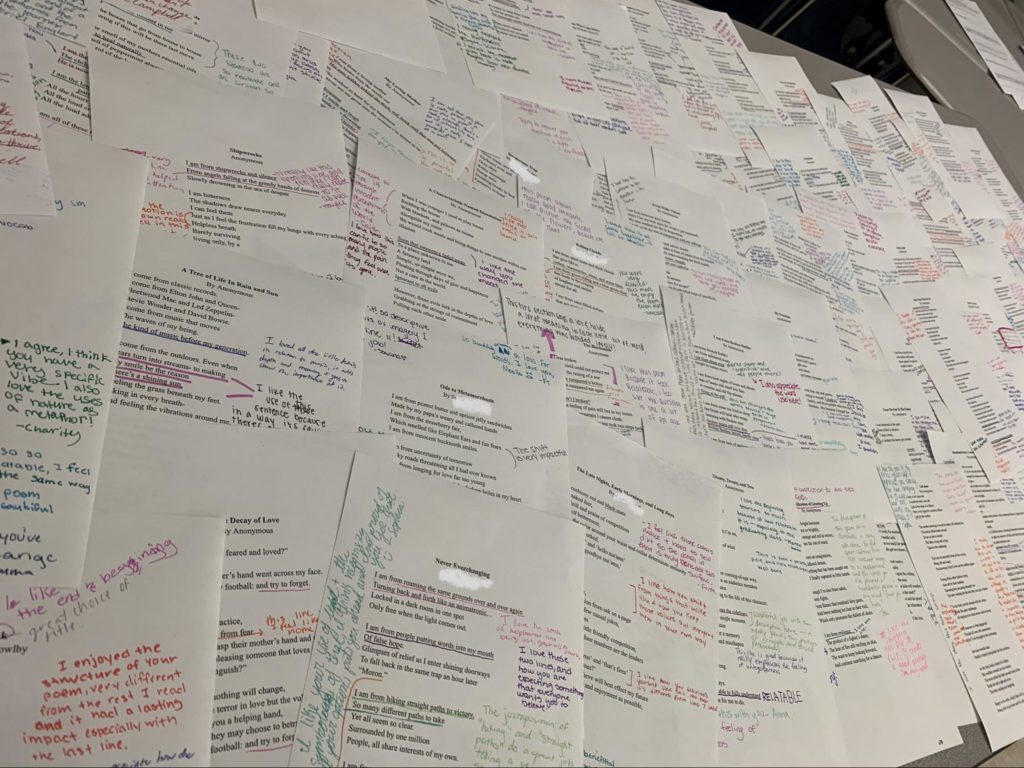
Step 1: The Project
The task itself was constructed from the poem The place I’m From by George Ella Lyon—when you’re studying this, you will have used this poem in your personal classroom earlier than!—with a number of slight modifications.
After some brainstorming round exact imagery, college students have been supplied the exemplar “The place I’m From” poem by Lyon together with this immediate:
Write a 15+ line, 3+ stanza narrative poem that engages together with your previous (“the place I’m from”), your current (“the place I’m”) and/or your future (“the place I shall be”) that features at the very least three particular examples of images/symbolism.
Listed below are two particular modifications I made to the task, figuring out that the gallery stroll was our final vacation spot:
- College students may request for his or her poem to be nameless for the gallery stroll. Particularly after final 12 months’s distance studying and the heightened stressors and anxieties on the shoulders of scholars, the very last thing I needed to do was make college students really feel uncomfortable with the exercise. Giving them the choice of anonymity as they shared their narrative writing with friends was a vital step that I extremely advocate.
- Including “Current” and “Future” as a substitute of simply “Previous.” That is additionally motivated by giving college students freedom to put in writing about what they felt snug writing about, and possibly extra importantly to not write about one thing they didn’t wish to share. Significantly in an train that might finish with sharing their writing with friends, this was a solution to improve flexibility. It additionally provided extra creativity by way of chronology and construction, which many utilized in superior methods.
Lastly, what I do with most writing assignments for my courses however all the time with inventive/narrative workout routines: I created my very own exemplars to share with them. I’m an enormous advocate of leaning into exemplars to assist college students develop as writers; I additionally consider within the reciprocity that takes place as a trainer when sharing my very own writing with them first.
College students got brainstorming time after which had slightly over every week to create and submit their closing product—all whereas we have been diving into our poetry unit, which provided much more examples by the masterful poetry of Gwendolyn Brooks and Emily Dickinson. (You may by no means have sufficient exemplars!) For these inquisitive about what sort of outcomes you possibly can find yourself with, here’s a peek at seven of the poems college students created.
Step 2: The Instructor Suggestions
Right here’s the step that I’ve skipped previously that I added this time earlier than the gallery stroll that I extremely advocate prioritizing for these embarking in direction of the ultimate stage of this sequence: providing affirming trainer suggestions earlier than the gallery stroll.
Sure, this does take time—and I really used a built-in function in our college’s on-line Canvas platform to file a pair minutes of audio suggestions for every submission. Do that with almost 100 poems, and that’s no small chunk of time, both.
Why make investments this suggestions earlier than the gallery stroll? Right here is my three-part rationale:
- College students entered into this exercise in every single place by way of their very own confidence of their writing, so I consider it was crucial to assist construct their very own perception in themselves as writers previous to coming into the gallery stroll house.
- Working backwards from the objective of the gallery stroll to be a secure, affirming house, something that I may do as a trainer to embolden college students was about investing within the potential of that house itself.
- Lastly, with all narrative writing, I feel lecturers have a accountability to look by what college students submit earlier than it’s shared publicly and/or with friends, as you by no means know what’s going to flip up in the sort of writing!
As one scholar remarked to me after listening to the audio suggestions, “Mr. Luther, I didn’t assume what I wrote would get throughout to anybody, however you bought it! So I really feel so much higher about what I wrote now.” That shift—to a spot of feeling at the very least considerably assured in their very own writing (which we had already been engaged on with our Lovely Language Wall all through the semester)—was the objective of the suggestions prior to the gallery stroll.
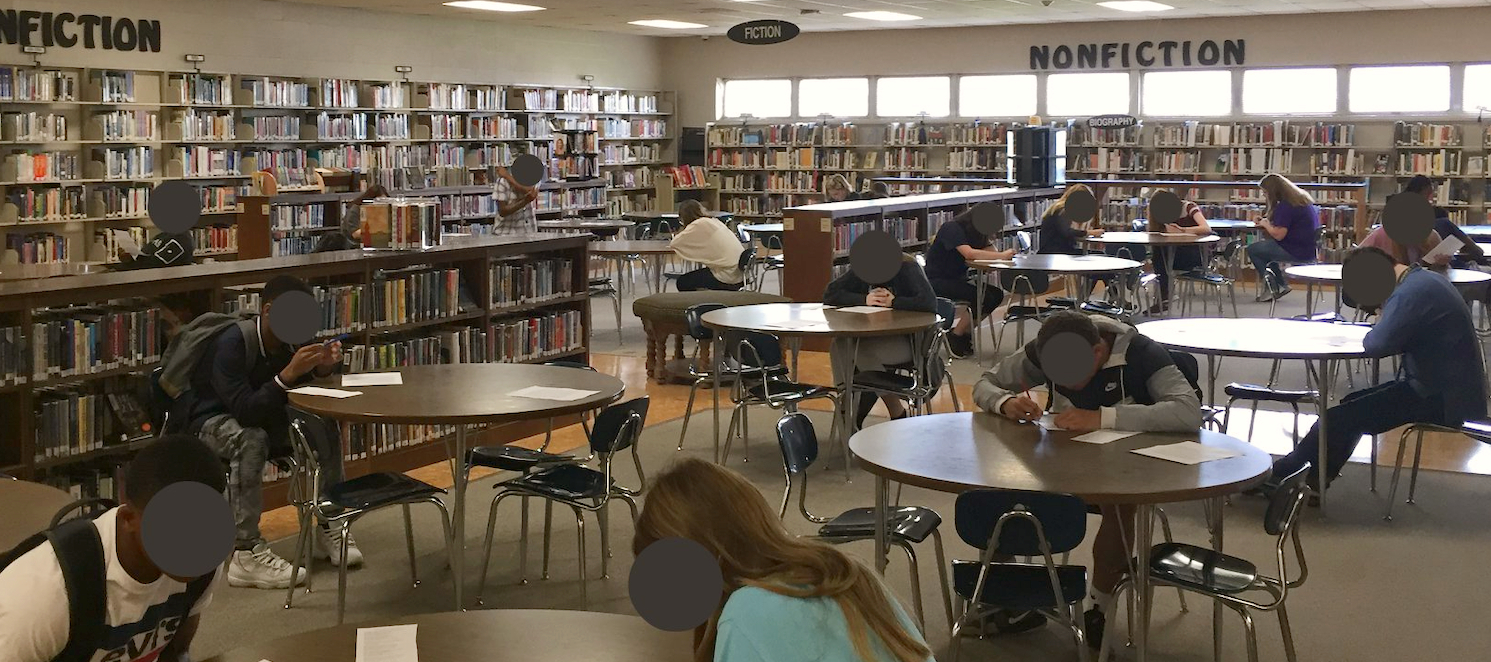
Step 3: Planning and Creating the Gallery Stroll Area
I’ve accomplished this exercise at a number of faculties, and every time I attempt to make it possible for this takes place exterior of the classroom. I often lean on our college library as the most effective potential house.
In my eyes, there’s a good thing about creating a distinct environment just by moving into a brand new house. It makes the day really feel completely different for college students, and in addition has the additional advantage of stepping right into a a lot bigger house that offers college students the proximity to be current in their very own reflection and affirmation. (And silent, as I’ll focus on in Step 4.)
After reviewing the poems, I bodily printed out every of them and made certain to double-check and triple-check which college students had requested theirs to be nameless. I gave our media specialist a heads up about what we might be doing, and he or she and her workforce did the remainder of the work in ensuring the library can be arrange for an unbelievable expertise.
(And being comparatively new to my present faculty, I genuinely appreciated the prospect to attach with colleagues past my classroom—as I’ve the unhealthy behavior, as I’m certain many lecturers do, of unintentionally discovering myself remoted at occasions in my very own classroom.)
The set-up is versatile to your context, however listed below are three options I’d provide:
- More room = higher. We unfold out the poems as a lot as attainable throughout the library, throughout empty cabinets and tables, to make it possible for college students may have the house they wanted to heart themselves within the suggestions. (Notice: in case you are in a classroom, taping them on the partitions can be one other choice to unfold them out extra!)
- Stop as many interruptions as attainable. That is why I just like the library as a setting: it’s a silent house. However even when you do that in your classroom, attempt to anticipate any potential disruptions. As I’ll focus on within the subsequent part, sustaining silence is a vital a part of making this the most effective expertise attainable.
- Attempt to get coloured pens of varied colours. Together with probably going to a brand new house, including on this small step—equipping every scholar with their very own coloured pen for the exercise—makes it really feel completely different from the get-go, and in addition has the additional advantage of constructing the gathering of different-colored peer affirmations on the finish on every paper fairly a factor to behold for the scholars receiving their poems again.
Lastly, one alternative I made this time was to have college students full this peer gallery stroll with the poems from all class durations somewhat than simply their present class interval. I made this alternative as a result of at our college scholar schedules shift so much at semester break, which implies that many college students transfer into completely different AP Literature sections for the second half of the 12 months. For that reason, I needed college students to see and affirm poems from all of the courses to start laying the groundwork for our classroom communities going ahead—however in your courses you would possibly discover extra consolation and worth in your college students to solely share their writing with their very own class interval.
Step 4: Day-Of Norming and Framing
I can’t overstate this: The way you body the gallery stroll will form this expertise.
So listed below are the 4 steps that befell the day of the gallery stroll this 12 months in our classroom earlier than we headed all the way down to the library for it to happen:
- In our classroom, we commonly heart the poem “In Lak’ech” by Luis Valdez by choral studying—connecting to our price of generosity—so we started there, as I requested college students to brainstorm a time the place they didn’t obtain the affirmation and help they wanted and what that felt like (or a time during which they didn’t provide it to another person who wanted it).
- From there, we shifted to the facility of affirmation in our lives and set that as a objective for every of them individually, as college students have been requested to silently mirror on what it means to ensure one other individual’s story isn’t solely heard however affirmed—as that was precisely the chance we have been about to enter into.
- Thirdly, we went over 4 other ways to affirm one another’s writing: a) highlighting a particular phrase/line that stood out to you; b) providing a connection or a method their poem resonated with you; c) appreciating a fashion or model during which the poem was written; or d) naming and reflecting on a worth you seen inside the poem itself. I consider that this was one other crucial step, too, particularly for the primary class that might be working with clean poems to depart suggestions on.
- And eventually, we set a norm of silence—how the house can be silent from the second they entered till the second they left; how no partnering or dialogue would happen; how they’d keep current your complete time, which meant no cellphone checks or some other distraction. I provided to them to contemplate how uncommon silence actually is, too, in our lives, and the way typically we fend it off mechanically with earbuds or airpods: “How typically do you all get thirty minutes of silence, actually?”
(Notice: an extra norm I discovered useful so as to add in by the second class was to not spend any time or vitality looking for out your personal poem, as that might be taking away out of your means to be beneficiant together with your presence and affirmation in direction of friends.)
Then they every made certain that they had a distinct coloured pen from our class utensils bin (and a back-up, simply in case!) and we made our method down—and it 100% lived as much as every thing I may have anticipated and extra:
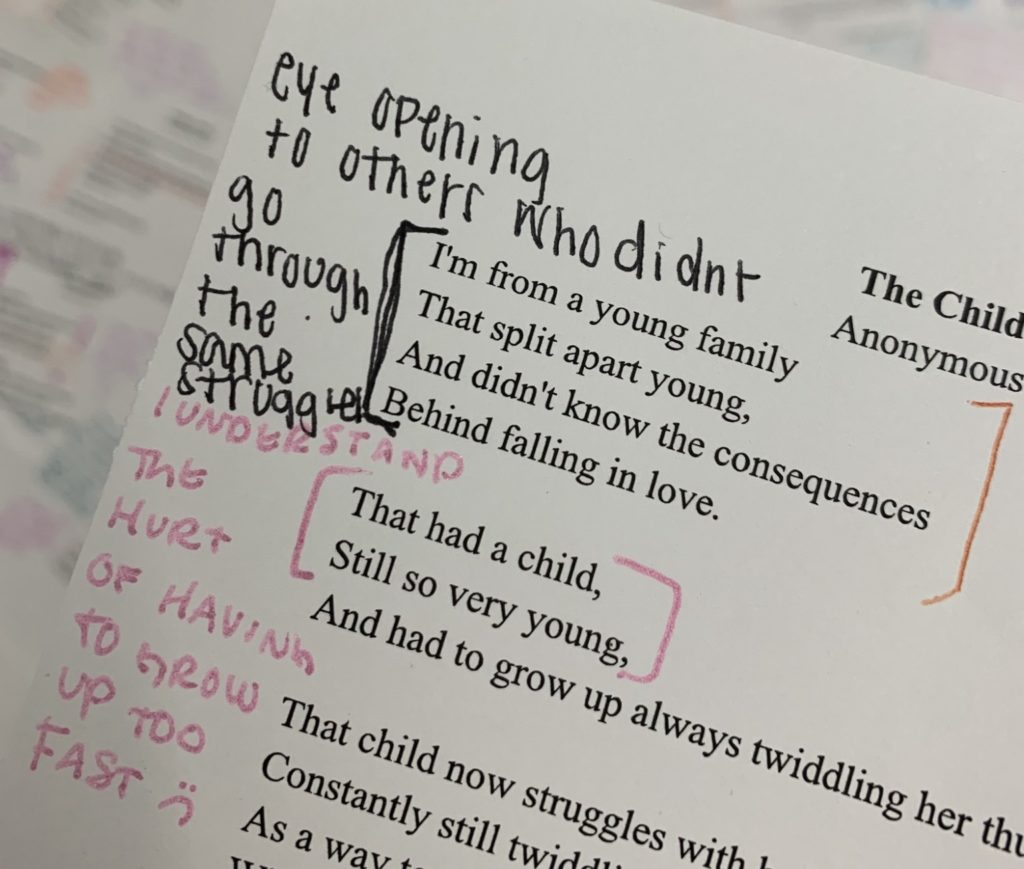
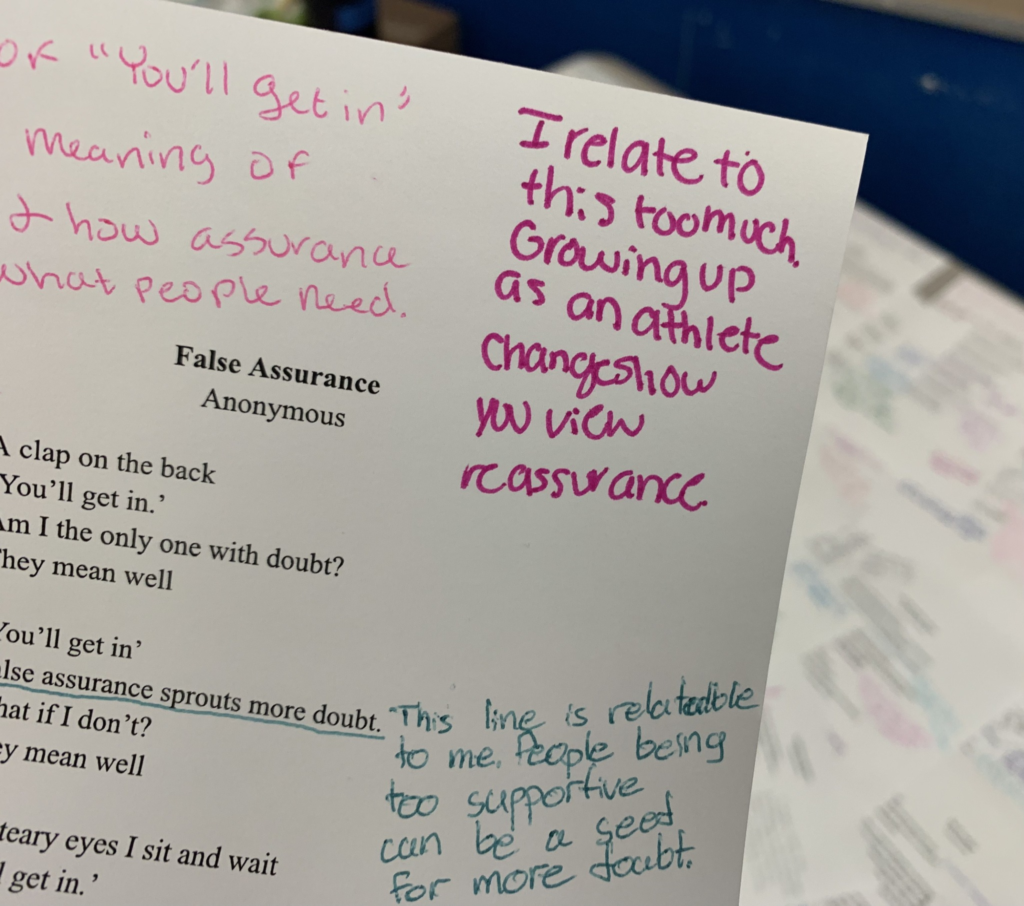

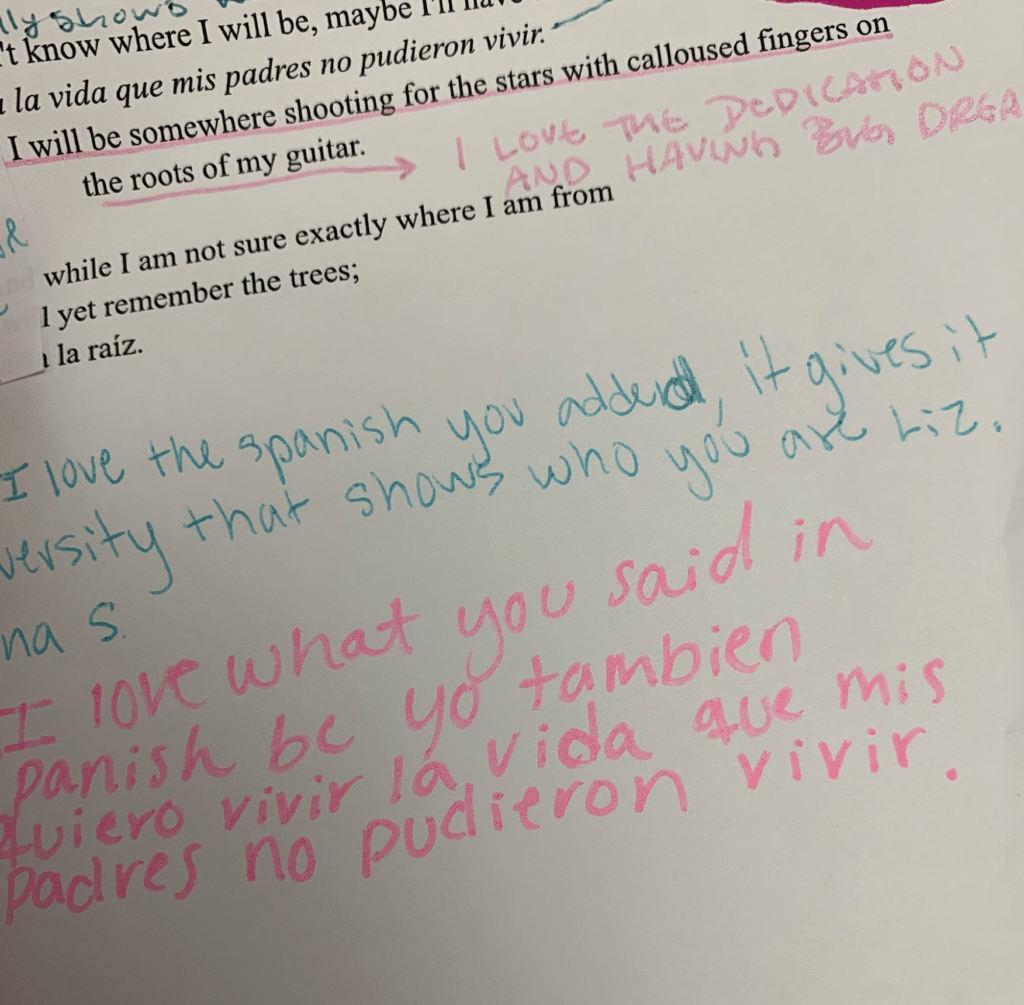
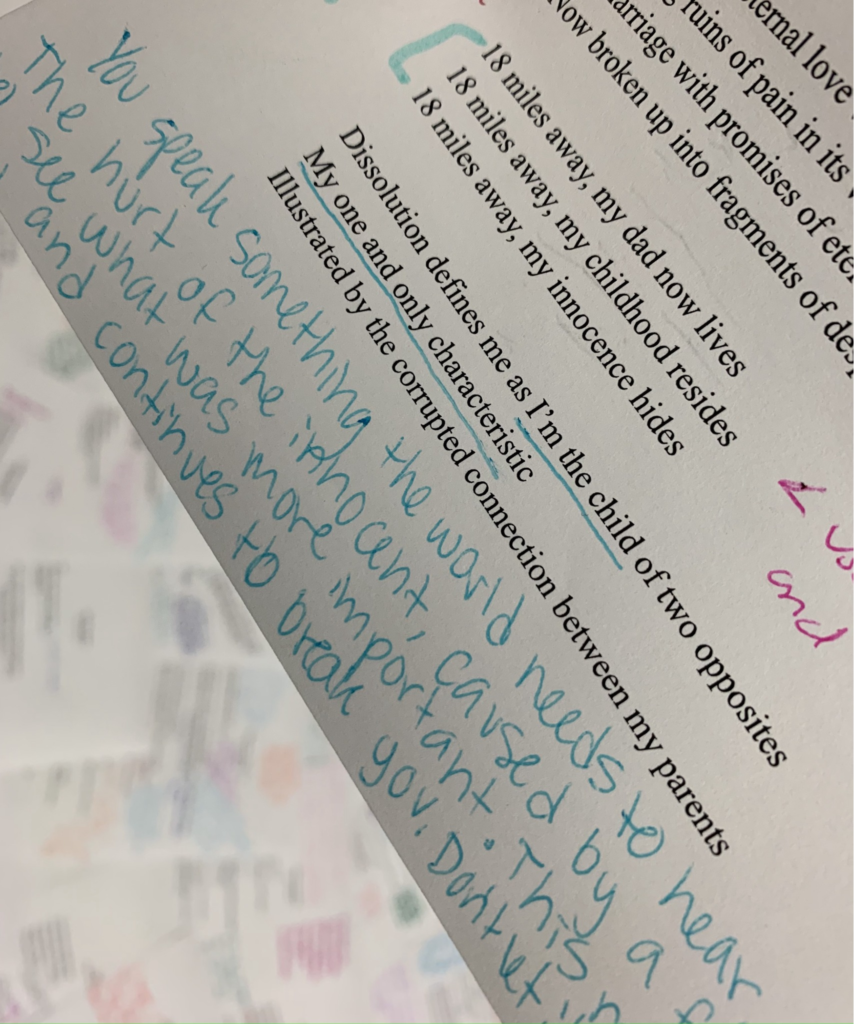
Step 5: Creating Closure
Once we returned to the classroom after this exercise, we in fact took time to debrief—first individually after which collectively. In whole-class remarks, one scholar famous simply what number of patterns they noticed throughout the varied poems, how typically the pasts and futures of the completely different tales translated into each other. How empathy may stroll hand-in-hand with individuality.
And naturally this led to the simple pivot to how we opened that lesson, with the primary two strains of “In Lak’ech”: Tu eres mi otro yo. / You might be my different me.
As soon as all of the gallery walks have been accomplished, college students have been handed again their poems—and you possibly can really feel the nervousness as they awaited the feedback of their friends, even figuring out that these have been stuffed with affirmation. The couple college students who have been absent after they have been handed again instantly requested for theirs after they returned to class, too, demonstrating the urgency that lingered even every week after the exercise.
Lastly, then, we ended our semester simply final week with one closing iteration of this exercise, weeks after it had taken place: I handed out the next poem, which pulled from myriad of the poems to deliver them collectively right into a single collage poem, an indication of the synchronicity throughout their writing one final time.
That collective poem ended with a rhyming couplet, from two completely different college students’ poems fused collectively:
Easy, so easy have been we / I’m a shadow solely mirrors can see
One closing reminder that generally we have to see one another to see ourselves.
Some Closing Why Ideas
In order that was the how—however I wish to circle again to the why yet another time.
I do know in my very own profession, generally I discover a chasm rising between the values I current to college students and the precise method time is spent in our classroom. There are myriad causes for that, particularly in a 12 months during which “urgency” is being pressured upon lecturers to make up for “misplaced studying” and assist get college students “again on monitor.”
Generally I discover a chasm rising between the values I current to college students and the precise method time is spent in our classroom.
As an alternative, although, this 12 months I used to be decided to carry myself accountable to the chance that was the bodily classroom, one thing I’ve discovered myself treasuring greater than ever since having to work in a digital house for almost a 12 months.
Prioritizing our values of generosity and group as a classroom meant investing the time to make these priorities a actuality.
And that’s actually all it takes, too, as everyone knows how a lot pleasure and inspiration college students themselves stroll into our rooms with every day. It’s what makes this work price it regardless of every thing else, and why the stubbornness of my hope all the time appears to outlast the omnipresence of outdoor cynicisms.
As one scholar wrote upon one other’s poem, “I can really really feel this hope.”
What higher method to make use of the classroom house is there, actually?
Oh, And a Ultimate Factor!
In case you efficiently deliver this to life in your personal lecture rooms, I’d like to let my college students see a glimpse of how their affirmations stretched past our personal classroom group and into others—be at liberty to e mail me at marcus.luther@gmail.com to share any outcomes! (or when you have any questions/clarifications, which I’d be pleased to help you with!)
Be part of our mailing record and get weekly suggestions, instruments, and inspiration that may make your instructing more practical and enjoyable. You’ll get entry to our members-only library of free downloads, together with 20 Methods to Lower Your Grading Time in Half, the e-booklet that has helped 1000’s of lecturers save time on grading. Over 50,000 lecturers have already joined—come on in.

